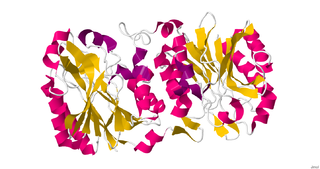| Arthrobacter aurescens | |
|---|---|
| Scientific classification | |
| Kingdom: | Bacteria |
| Phylum: | Actinobacteria |
| Order: | Actinomycetales |
| Family: | Micrococcaceae |
| Genus: | Arthrobacter |
| Species: | A. aurescens |
| Binomial name | |
| Arthrobacter aurescens Phillips 1953 [1] | |
| Type strain | |
| AJ 1430, ATCC 13344, BCRC 12110, CBRI 21002, CBRI 579, CCM 1649, CCRC 12110, CCUG 23839, CCUG 23885, CDA 579, CGMCC 1.1892, CIP 102364, DSM 20116, H.J. Conn, HAMBI 1850, IAM 12340, IFO 12136, IMET 11247, IMSNU 21002, JCM 1330, KCTC 3378, LMD 72.18, LMG 3815, Lochhead, NBIMCC 2010, NBRC 12136, NCCB 72018, NCIB 891, NCIB 8912, NCIMB 8912, NRIC 0150, NRRL B-2879, VKM Ac-1105, VKM Ac-1124, VKM B-800 [2] | |
Arthrobacter aurescens is a bacterium species from the genus of Arthrobacter . [1] [3] [4] Arthrobacter aurescens produces nitrilase and L-N-carbamoylase. [5] [6] [7] Arthrobacter aurescens has a low GC-content and has the ability to utilize anethole. [8] [9]

Arthrobacter is a genus of bacteria that is commonly found in soil. All species in this genus are Gram-positive obligate aerobes that are rods during exponential growth and cocci in their stationary phase. Arthrobacter have a distinctive method of cell division called "snapping division" or reversion in which the outer bacterial cell wall ruptures at a joint.

Nitrilase enzymes catalyse the hydrolysis of nitriles to carboxylic acids and ammonia, without the formation of "free" amide intermediates. Nitrilases are involved in natural product biosynthesis and post translational modifications in plants, animals, fungi and certain prokaryotes. Nitrilases can also be used as catalysts in preparative organic chemistry. Among others, nitrilases have been used for the resolution of racemic mixtures. Nitrilase should not be confused with nitrile hydratase which hydrolyses nitriles to amides. Nitrile hydratases are almost invariably co-expressed with an amidase, which converts the amide to the carboxylic acid. Consequently, it can sometimes be difficult to distinguish nitrilase activity from nitrile hydratase plus amidase activity.

In molecular biology and genetics, GC-content is the percentage of nitrogenous bases on a DNA or RNA molecule that are either guanine or cytosine. This may refer to a certain fragment of DNA or RNA, or that of the whole genome. When it refers to a fragment of the genetic material, it may denote the GC-content of section of a gene (domain), single gene, group of genes, or even a non-coding region.


